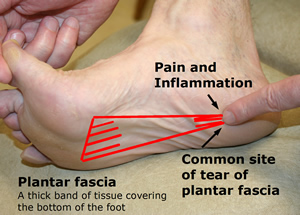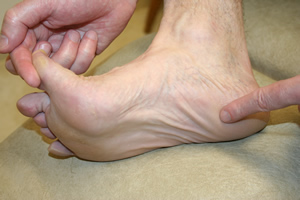Plantar Fasciitis
What is Plantar Fasciitis?
[Commonly known as
Policeman's Heel]
Heel Pain
Plantar fasciitis is a common foot condition which causes pain and inflammation under the heel. It is also known as policeman’s heel or policemans foot.
The plantar fascia is a strong thick band of fibrous tissue that attaches underneath the heel bone and spans out to the base of the toes. It helps supports the arch. If the plantar fascia is stretched too much or too often then inflammation and small tears in the fibres can occur especially where the fascia attaches to the heel bone. One third of sufferers have the problem in both feet.
 |

Do you have plantar fasciitis?
Do you have pain and tenderness when you stretch the plantar fascia and press on the inside of the heel? |
Symptoms of Plantar Fasciitis
Heel pain is the main symptom. Pain is normally felt underneath the foot where the plantar fascia attaches to the heel, however pain can occur anywhere along the plantar fascia.
The pain is often worse in the morning when getting out of bed or on standing up after sitting down during the day. The first few steps can be intensely painful. The sharp pain will gradually disappear after a few minutes of walking but can then increase throughout the day as activity increases. You may limp because of the pain.
Who can get Plantar Fasciitis?
- People over 40 but not necessarily
- Athletes, especially those that change their running schedule or technique
- People who do lots of walking, running and standing when they are not used to it
- People who wear non-supportive shoes
- People who are overweight
- People who overuse their feet
- People with tight calf muscles
- People who excessively pronate (internally rotate) their feet
- People with flat feet
- People who have jobs which involve a lot of standing on hard surfaces
Sometimes an x-ray will show a bone spur on the heel but this is rarely the cause of the pain.
Healing
The plantar fascia will heal very slowly but if the area is continually aggravated and damaged by standing and walking, fibres will continue to be torn.
Without treatment about 80% of plantar fasciitis will heal in approximately 18 months. The other 20% will be left with a chronic condition causing severe pain.
Treatment for Plantar Fasciitis
Combining several treatments can help speed up the repair process. It is unlikely that one treatment alone will allow the heel to recover properly.
Treatment
What you should do First |
| |
Rest - rest the foot as much as possible, avoid exercise until the area feels better |
| |
Avoid barefoot walking - do not walk barefoot especially on hard surfaces |
| |
Orthotics - a functional orthotic (insole) worn inside your shoe can improve foot function and stop excessive pronation (where the foot rolls in too much). Along with calf stretching, orthotics are often the most effective treatment. Also see ready made Orthaheel orthotics and Superfeet insoles. |
| |
Stretching - gradual gentle stretching to the calf muscles and the plantar fascia to reduce tightness, reduce stress on the heel and reduce pain when getting up from bed first thing in the morning. Consider purchasing a night splint to stretch the plantar fascia and the calf muscles at night. |
| |
Footwear - old or broken down shoes do not give enough support to the foot. Choose shoes with a good arch support. A training or sports shoe is probably the best type of shoe. |
| |
Acupuncture - can help reduce the pain |
| Treatment - Second Choice |
| |
Taping - tape applied in strips underneath the foot will help support and rest the foot |
| |
Ice - ice applied to the painful area for 10 minutes 3-4 times per day will reduce inflammation. Gel ice packs are the easiest way of applying ice. |
| |
Plantar fasciitis night splint - worn overnight will help to gently stretch the calf muscles and plantar fascia. Use the soft Procare night splint, a more substantial splint such as the ProCare Night Splint, or a Strassburg Sock. Combine a night splint with a day plantar fasciitis splint such as the Aircast Plantar Fasciitis AirHeel which is lightweight and comfortable. More information on plantar fasciitis splints. |
| |
Massage and mobilisation - will reduce the tension in the plantar fascia and help stretching of the tissue |
| |
Painkillers - paracetamol will help ease the pain
Anti-inflammatory medication/NSAIDs - such as ibuprofen will reduce inflammation |
| Treatment - if all else fails |
| |
Injections - a steroid (cortisone) injection can help reduce inflammation in the heel. Sometimes local anaesthetic is also injected in at the same time. It should only be considered if the heel pain remains severe despite all other options because it can cause tissue rupture and atrophy |
| |
Plaster Cast to the lower leg - can be applied in very severe cases to rest the foot |
| |
Surgery - may be considered in extremely severe and difficult cases that will not respond to any other treatment. Surgery is not always successful and should always be considered the absolute last resort. |
|

